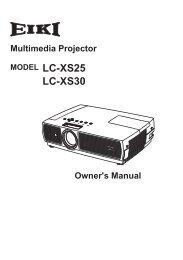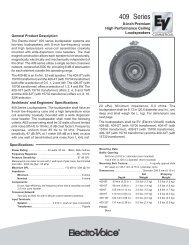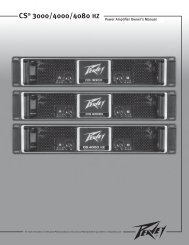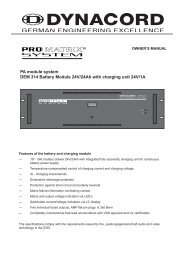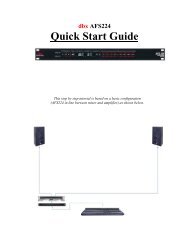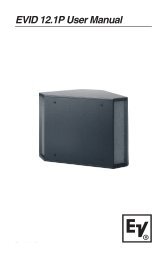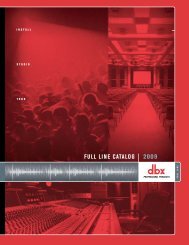DPA 4140 Manual - Loyola Enterprises Inc. Audio Visual Systems
DPA 4140 Manual - Loyola Enterprises Inc. Audio Visual Systems
DPA 4140 Manual - Loyola Enterprises Inc. Audio Visual Systems
Create successful ePaper yourself
Turn your PDF publications into a flip-book with our unique Google optimized e-Paper software.
POWER AMPLIFIER <strong>DPA</strong> 4120 / <strong>DPA</strong> <strong>4140</strong> OWNER'S MANUAL<br />
Performance Features<br />
<strong>DPA</strong> <strong>4140</strong><br />
400 WATTS POWER AMPLIFIER<br />
Power amplifier with 200 W or 400 W output power according to the IEC 283-3 standard within a<br />
19“ - cabinet (3 HU) providing the following functions:<br />
supported are 115/230V AC mains as well as 24V DC emergency power source<br />
power amplifiers <strong>DPA</strong> 4120 providing 200 W or <strong>DPA</strong> <strong>4140</strong> providing 400 W output power, idling and short-circuit<br />
protection<br />
output transformer for balanced, floating 100 V speaker networks of optionally 70 V, 50 V or<br />
4 ohms for low-impedance operation<br />
optional input modules:<br />
standard operation INPUT MODULE with level control, electronically balanced input and MONITOR output with<br />
optional transformer or<br />
REMOTE MODULE for controlling and monitoring the PROMATRIX system, electronic level controls,<br />
electronically balanced input and MONITOR output with optional transformer<br />
integrated stand-by power supply<br />
mains POWER ON/OFF switch<br />
ground lift switch<br />
remotely controllable mains and battery operation with initial current inrush limiter<br />
power-on switching noise suppression<br />
status-LED indicators for operation (READY), STANDBY, thermal overload (PROTECT) and<br />
occurrence of GROUND FAULT conditions at the power output<br />
fault message according to the IEC 849 standard<br />
TEST button to switch between system and average operation, respectively a RESET button to restart after the<br />
occurrence of ground fault conditions<br />
LED level meter instrument with a display range of -13 dB to 0 dB and CLIP<br />
integrated relays for single call and obligatory reception<br />
active, temperature controlled ventilation<br />
pilot tone and ground fault surveillance module according to the DIN/VDE 0800 standard (optional)<br />
The extension-kit NRS 90208 (input transformer) has been integrated in the input module NRS 90222<br />
starting with the serial number 10461 and in the input module NRS 90225 starting with the serial number<br />
12339 and higher.<br />
23<br />
CLIP<br />
0dB<br />
-13dB<br />
READY<br />
GROUND<br />
FAULT<br />
TEST<br />
STANDBY<br />
PROTECT
24
Indicators, controls and connections<br />
POWER<br />
AC MAINS INPUT<br />
115V /230V AC 50-60 Hz<br />
CAUTION: FOR CONTINUED PROTECTION AGAINST RISK OF FIRE<br />
REPLACE WITH SAME TYPE AND VALUE FUSE INDICATED.<br />
ATTENTION: REMPLACER PAR UN FUSIBLE DE MEME TYPE<br />
COMME INDIQUE.<br />
DC INPUT 24V<br />
+<br />
T4A FOR 230V<br />
T8A FOR 115V<br />
CIRCUIT TO<br />
CHASSIS SWITCH<br />
GROUNDED<br />
UNGROUNDED<br />
VOLTAGE<br />
SELECTOR<br />
115V 230V<br />
NO USER SERVICEABLE PARTS INSIDE. REFER SERVICING<br />
TO QUALIFIED SERVICE PERSONNEL.<br />
VOR ÖFFNEN DES GERÄTES NETZSTECKER ZIEHEN<br />
1 2<br />
8 7 6<br />
121629<br />
POWER OUTPUT<br />
1 2 3 4 5<br />
<strong>DPA</strong> <strong>4140</strong><br />
400 WATTS POWER AMPLIFIER<br />
A 9 A 10 11 12 A<br />
13<br />
CAUTION<br />
RISK OF ELECTRIC SHOCK<br />
DO NOT OPEN<br />
WARNING: TO REDUCE THE RISK OF FIRE OR ELECTRIC SHOCK,<br />
DO NOT EXPOSE THIS APPLIANCE TO RAIN OR MOISTURE.<br />
AVIS: RISQUE DE CHOC ELECTRIQUE. NE PAS OUVRIR.<br />
20 19 18 17<br />
<strong>DPA</strong> <strong>4140</strong><br />
MADE IN GERMANY<br />
ADDRESS<br />
OUTPUT<br />
VOLTAGE<br />
B<br />
A<br />
CLIP<br />
0dB<br />
-13dB<br />
READY<br />
GROUND<br />
FAULT<br />
TEST<br />
STANDBY<br />
PROTECT<br />
B<br />
4 5 6<br />
3 7<br />
2 8<br />
1 9<br />
0 10<br />
LEVEL<br />
REMOTE<br />
CONTROL<br />
A 9 A 10 11 12 A 15 B<br />
POWER<br />
AC MAINS INPUT<br />
115V /230V AC 50-60 Hz<br />
CAUTION: FOR CONTINUED PROTECTION AGAINST RISK OF FIRE<br />
REPLACE WITH SAME TYPE AND VALUE FUSE INDICATED.<br />
ATTENTION: REMPLACER PAR UN FUSIBLE DE MEME TYPE<br />
COMME INDIQUE.<br />
+<br />
CAUTION<br />
RISK OF ELECTRIC SHOCK<br />
DO NOT OPEN<br />
T4A FOR 230V<br />
T8A FOR 115V<br />
WARNING: TO REDUCE THE RISK OF FIRE OR ELECTRIC SHOCK,<br />
DO NOT EXPOSE THIS APPLIANCE TO RAIN OR MOISTURE.<br />
AVIS: RISQUE DE CHOC ELECTRIQUE. NE PAS OUVRIR.<br />
CIRCUIT TO<br />
DC INPUT 24V<br />
CHASSIS SWITCH<br />
GROUNDED<br />
UNGROUNDED<br />
VOLTAGE<br />
SELECTOR<br />
115V 230V<br />
NO USER SERVICEABLE PARTS INSIDE. REFER SERVICING<br />
TO QUALIFIED SERVICE PERSONNEL.<br />
VOR ÖFFNEN DES GERÄTES NETZSTECKER ZIEHEN<br />
121629<br />
POWER OUTPUT<br />
1 2 3 4 5<br />
20 19 18 17<br />
1 level meter instrument<br />
2 CLIP indicator<br />
3 Test and Reset button TEST<br />
4 STANDBY indicator<br />
5 Fault indicator PROTECT<br />
6 Fault indicator GROUND FAULT<br />
7 Mode indicator READY<br />
8 Ventilation louvres<br />
9 Mains power switch POWER<br />
10 Mains power connector AC MAINS INPUT<br />
11 Mains fuse FUSE<br />
12 Mains VOLTAGE SELECTOR<br />
13 Input LEVEL control<br />
14 INPUT socket<br />
15 THRU socket<br />
25<br />
<strong>DPA</strong> <strong>4140</strong><br />
MADE IN GERMANY<br />
ADDRESS<br />
OUTPUT<br />
VOLTAGE<br />
B<br />
A<br />
INPUT<br />
B<br />
THRU<br />
IN<br />
REMOTE<br />
CONTROL<br />
OUT<br />
STATUS<br />
INPUT<br />
THRU<br />
90225<br />
ADDRESS<br />
16 REMOTE CONTROL connector<br />
17 POWER OUTPUT<br />
18 Ventilation louvres<br />
19 CIRCUIT TO CHASSIS SWITCH<br />
20 DC INPUT 24V = (battery)<br />
21 IDENT ADDRESS switch<br />
22 REMOTE CONTROL connectors<br />
23 STATUS indicator<br />
A locking screws power supply printed board<br />
B locking screws INPUT MODULE<br />
B<br />
90222<br />
A<br />
B<br />
3<br />
4<br />
5<br />
14<br />
15<br />
16<br />
14<br />
21<br />
22<br />
23
Contents<br />
Performance Features ................................................................................................................................. 23<br />
Indicators, controls and connections ........................................................................................................... 25<br />
1. Utilization ..................................................................................................................................................... 27<br />
2. Installation ................................................................................................................................................... 27<br />
3. Before the first operation.............................................................................................................................. 27<br />
3.1 Mains operation ................................................................................................................................... 27<br />
3.2 Battery operation 24V DC..................................................................................................................... 28<br />
4. INPUT .......................................................................................................................................................... 28<br />
5. Outputs......................................................................................................................................................... 29<br />
5.1 POWER OUTPUT................................................................................................................................. 29<br />
5.2 POWER OUTPUT for 100V (70V or 50V) loudspeaker systems ......................................................... 29<br />
5.3 SINGLE CALL and obligatory reception relays OVERRIDE BYPASS................................................. 29<br />
5.4 POWER OUTPUT for low impedance loudspeaker systems............................................................... 29<br />
5.5 MONITOR output .................................................................................................................................. 30<br />
5.6 REMOTE CONTROL connector (only NRS 90225) ............................................................................. 30<br />
6. Indicators ..................................................................................................................................................... 30<br />
6.1 STANDBY indicator .............................................................................................................................. 30<br />
6.2 READY indicator ................................................................................................................................... 30<br />
6.3 PROTECT indicator .............................................................................................................................. 30<br />
6.4 GROUND FAULT indicator................................................................................................................... 30<br />
6.5 Aussteuerungskontrolle und CLIP-Anzeige.......................................................................................... 31<br />
7. Switching the output voltage........................................................................................................................ 31<br />
8. Enhanced application field........................................................................................................................... 32<br />
8.1 General input module NRS 90225........................................................................................................ 32<br />
8.2 Remote module NRS 90222................................................................................................................. 32<br />
8.3 NRS 90208 input transformer for the floating, balanced input ............................................................. 33<br />
8.4 NRS 90227 output transformer for the floating, balanced monitor output............................................ 33<br />
8.5 NRS 90224 pilot tone and ground fault surveillance ............................................................................ 35<br />
8.5.1 Pilot tone surveillance ................................................................................................................. 35<br />
8.5.2 Ground fault surveillance ............................................................................................................ 35<br />
9. 19"-case and 19“-rack shelf system installation .......................................................................................... 38<br />
10. Ground lift switch CIRCUIT TO CHASSIS SWITCH ................................................................................. 38<br />
11. Fuses ........................................................................................................................................................... 38<br />
11.1 Fuses in the <strong>DPA</strong> ................................................................................................................................ 38<br />
11.2 Fuses in the <strong>DPA</strong>................................................................................................................................ 38<br />
12. Power amplifier specifications ..................................................................................................................... 42<br />
12.1 <strong>DPA</strong> 4120 power amplifier 200 W....................................................................................................... 42<br />
12.2 <strong>DPA</strong> <strong>4140</strong> power amplifier 400 W....................................................................................................... 43<br />
13. Extension specifications............................................................................................................................... 44<br />
13.1 NRS 90225 general input module....................................................................................................... 44<br />
13.2 NRS 90222 remote module ................................................................................................................ 44<br />
13.3 NRS 90208 input transformer for floating, balanced input ................................................................. 44<br />
13.4 NRS 90227 output transformer for floating, balanced monitor output................................................ 44<br />
13.5 NRS 90224 pilot tone and ground fault surveillance .......................................................................... 44<br />
14. Block diagrams ............................................................................................................................................ 67<br />
14.1 Power amplifiers <strong>DPA</strong> 4120 / <strong>DPA</strong> <strong>4140</strong> ............................................................................................. 67<br />
14.2 NRS 90225 general input module....................................................................................................... 68<br />
14.3 NRS 90222 remote module ................................................................................................................ 69<br />
14.4 NRS 90224 pilot tone and ground fault surveillance .......................................................................... 70<br />
15. Warranty....................................................................................................................................................... 72<br />
26
1. Utilization<br />
The amplifiers <strong>DPA</strong> 4120 and <strong>DPA</strong> <strong>4140</strong> are specially designed for the power-consistent and reliable operation of<br />
PA-systems. The <strong>DPA</strong> 4120 and <strong>DPA</strong> <strong>4140</strong> are intended to be used in company intercom, alarm and background<br />
music transmission installations, offices and commercial areas, congregation and sport centers, schools, churches,<br />
hotels, hospitals, shopping malls and super markets, cruise ships, and other similar applications.<br />
2. Installation<br />
When installing the amplifiers, it is important to assure that for ventilation reasons the front-to-rear air circulation is<br />
guaranteed (for details on 19"-case or 19“-rack shelf installation please refer to paragraph 9).<br />
To maintain EMC it is necessary that all input, output, and control lines – except for the power cords – are shielded.<br />
Within metal housings or closed rack shelf systems, unshielded output and control cabling is allowable. Shielding is<br />
accomplished by connecting the individual cable screens to the enclosure or rack shelf ground potential.<br />
The amplifier has to be protected from:<br />
- water drops or splashes<br />
- direct sunlight<br />
- high ambient temperatures and the direct radiation of heat sources<br />
- high humidity and moisture<br />
- heavy dust<br />
- massive vibrations<br />
Moving the amplifier from a cold into a warm environment can result in the occurrence of condensation on inner<br />
parts. Operating the appliance is only permissible after it has accommodated to the altered temperature<br />
(approximately after one hour).<br />
Should it happen that foreign solid parts or liquids inadvertently intrude the enclosure, unplug the device from the<br />
power source and have it checked by a DYNACORD service center, before using it again.<br />
Cleaning the appliance should not be performed using chemical solvents or sprays, as this might damage the finish<br />
and moreover could cause hazard fire.<br />
3. Before the first operation<br />
These power amplifiers are designed to be operated with different input modules. The general input module NRS<br />
90225 is meant for all conventional applications. It allows to remotely start the amplifiers via control lines, monitor<br />
their operation by use of the incorporated fault relay, and monitor the transmitted audio signals through the monitor<br />
output. Using the remote control module NRS 90222, the amplifiers are connected to the PROMATRIX manager<br />
DPM 4000 via RS-485 remote interface providing complete remote operation and surveillance. The desired input<br />
module has to be inserted into the module shaft on the rear of the power amplifier. It has to be tightened using the<br />
two locking screws (B) (refer also to the paragraphs 8.1 and 8.2).<br />
3.1 Mains operation<br />
For normal AC mains operation, the included mains cord has to be connected to a 230V or 115V 50/60Hz wall<br />
outlet. On the appliance itself, the cord has to be connected to the 3-pole mains socket (10).<br />
Caution The appliance is factory preset to 230V AC. Switching to 115V AC is accomplished using the voltage<br />
selector (12).<br />
<strong>DPA</strong> 4120: For 115V AC operation, the mains fuse (11) has to be replaced by a slow blowing<br />
4 ampere type, labeled "T4A" (see also paragraph 11.1).<br />
<strong>DPA</strong> <strong>4140</strong>: For 115V AC operation, the mains fuse (11) has to be replaced by a slow blowing<br />
8 ampere type, labeled "T8A" (see also paragraph 11.2).<br />
27
If the appliance is correctly connected and mains is present the green STANDBY indicator (4) will light. To remotely<br />
start the amplifier when it is being operated on the mains, it is necessary to interconnect the contacts 3 - POWER<br />
REMOTE and 2 - GROUND STANDBY on the pin terminal strip REMOTE CONTROL (16) (see also paragraph<br />
5.6).<br />
The main power switch POWER (9) on the rear of the appliance is meant for service and maintenance purposes.<br />
This allows bridging the mains switching relay, which provides the possibility to operate the amplifier without<br />
remote start.<br />
Note The main power switch POWER (9) on the appliance's rear is only meant for maintenance.<br />
Remotely switching off the device is not possible when the POWER switch is engaged.<br />
Both amplifiers, the <strong>DPA</strong> 4120 and the <strong>DPA</strong> <strong>4140</strong>, employ power-on switching delays of approximately 3 sec. After<br />
this time, the green READY indicator lights and the READY fault message relay picks up when no error is being<br />
detected (see also paragraph 6.2).<br />
3.2 Battery operation 24V DC<br />
The amplifiers, <strong>DPA</strong> 4120 and <strong>DPA</strong> <strong>4140</strong>, use the mains or alternatively an external 24V battery as power source.<br />
Switching to battery is performed via integrated relays.<br />
The battery has to be connected on the rear of the amplifiers (20) using insulated 6.3x0.8 mm AMP flat plug<br />
connectors. The amplifiers are protected against polarity-mismatch. Each, the positive and negative conductors are<br />
internally protected by fuses, located on the printed board assembly 85270 (<strong>DPA</strong> 4120) respectively 85268 (<strong>DPA</strong><br />
<strong>4140</strong>) (see also paragraph 11, figure 10 and 11).<br />
The cable used for battery connection has to be at least 1.5 mm 2 in diameter (<strong>DPA</strong> 4120) respectively 2.5 mm 2<br />
(<strong>DPA</strong> <strong>4140</strong>). Using these diameters, the cable length for the one way distance should not exceed 4.0 m (max.<br />
voltage drop
figure 2 LF cable for coupling two amplifiers <strong>DPA</strong> 41xx<br />
5. Outputs<br />
5.1 POWER OUTPUT<br />
The power output is balanced and off-ground potential. The output is factory-configured for the connection of 100V<br />
loudspeaker systems. Connection has to be performed by inserting the supplied 5-pole plug into the power output<br />
socket (17). Switching the output voltage to 70V, 50V or to low impedance operation (4 ohms) is possible using the<br />
plug-in bridge B411 on the printed board assembly 84187 (<strong>DPA</strong> 4120) respectively 84175 (<strong>DPA</strong> <strong>4140</strong>) (see also<br />
paragraph 7).<br />
figure 3 connection of the power output<br />
5.2 POWER OUTPUT for 100V (70V or 50V) loudspeaker systems<br />
If the distance between the amplifier and the loudspeakers exceeds 50 m, it is recommended to operate the<br />
speaker systems using 100V matching transformers, to reduce line attenuation. This additionally offers a simple<br />
way of distributing the output power capacity. In this way it is possible to connect a maximum of as many<br />
loudspeaker systems as it takes until the total power consumption of the entire speaker network equals the power<br />
output capacity of 200W (connection impedance 50 ohms) with the <strong>DPA</strong> 4120, respectively 400W (connection<br />
impedance 25 ohms) with the <strong>DPA</strong> <strong>4140</strong>. Connection is performed using the 100V output (17) (see also figure 3).<br />
In a few special cases it is also possible to operate the loudspeaker systems with 70V or 50V output voltage (see<br />
also paragraph 7).<br />
Caution It is possible that during operation shock-hazard output voltages can be present at the POWER<br />
OUTPUT connector (>34V peak value). Thus, the connected loudspeaker groups have to be<br />
installed in accordance to applicable security standards and regulations (see also paragraph 8.5.2).<br />
5.3 SINGLE CALL and obligatory reception relays OVERRIDE BYPASS<br />
Combined with the PROMATRIX manager DPM 4000 or other external controls it is also possible to transmit single<br />
or collective calls with obligatory reception; i. e. bridging of possibly existing volume controls of the loudspeaker<br />
systems. For details on how to connect the outputs, please refer to figure 3; for the connection of relays, please<br />
refer to paragraph 5.6 respectively the PROMATRIX handbook.<br />
5.4 POWER OUTPUT for low impedance loudspeaker systems<br />
Switching the output to 4 ohms allows the connection of low impedance loudspeaker systems (4-16 ohms) (see<br />
also paragraph 7 and figure 3). Because of the occurring line attenuation, the distance between amplifier and<br />
loudspeaker system should not exceed 50m. Please make sure that the overall loudspeaker impedance does not<br />
decline a value of 4 ohms and that the stated power handling capacity of a single speaker system is not exceeded.<br />
29
5.5 MONITOR output<br />
The MONITOR output (16) on the NRS 90225 allows the connection of an additional power amplifier for monitoring<br />
purposes. The low impedance output is electronically balanced, which offers the possibility to achieve cable<br />
lengths of up to 200 m. Connection is performed via the REMOTE CONTROL pin-connector strip (see also figure<br />
4). For the remote control module NRS 90222, the MONITOR output is located on the REMOTE CONTROL<br />
connector (22). The PROMATRIX manager DPM 4000 switches the signal to the according the monitor channel. In<br />
case a floating output is required, the monitor output is prepared for retrofitting an output transformer; provided<br />
through the optional extension NRS 90227 (please also refer to paragraph 8.4).<br />
Note: Functioning changes in the models <strong>DPA</strong> 4120 (starting with serial numbers: 100 11) and <strong>DPA</strong> <strong>4140</strong><br />
(starting with serial numbers: 100 11) in association with the input module NRS 90225: To achieve reliable<br />
attenuation of switching noise (knacks), the monitor output stays muted as long as the READY-relay is not<br />
pulled. Because of circuit design reasons this causes that the monitor output is also muted even when a<br />
ground-fault appears at the main output.<br />
5.6 REMOTE CONTROL connector (only NRS 90225)<br />
The 15-pole sub-D REMOTE CONTROL pin-connector strip (16) provides several different control in-/outputs:<br />
- Ground of the stand-by power supply - negative pole grounded<br />
- POWER REMOTE - via contact to ground potential<br />
- BATTERY REMOTE - via contact to ground potential<br />
- MONITOR output - electronically balanced<br />
- READY-message - with floating contact<br />
- Obligatory reception relay D-RELAY - via contact to ground potential<br />
- Single call E-RELAY - via contact to ground potential<br />
2 STANDBY GROUND<br />
3 POWER REMOTE<br />
4 BATTERY REMOTE<br />
5 D - RELAY REMOTE CONTROL<br />
6 E - RELAY<br />
7<br />
8 READY<br />
15<br />
9 + MONITOR<br />
10 - MONITOR<br />
figure 4 connections on the REMOTE CONTROL pin-connector strip<br />
6. Indicators<br />
6.1 STANDBY indicator<br />
When the appliance is correctly connected and mains and/or battery power is present, the green STANDBY<br />
indicator (4) will light.<br />
6.2 READY indicator<br />
Both amplifiers, the <strong>DPA</strong> 4120 and the <strong>DPA</strong> <strong>4140</strong>, employ power-on switching delays of approximately 3 sec. to<br />
effectively eliminate power-on switching noise. After this time, the green READY indicator (7) lights and the READY<br />
fault message relay picks up when no error is being detected. When the power amplifier's mains transformer<br />
exceeds a certain value or, when – with installed NRS 90224 extension – the pilot tone falls below the threshold<br />
(see also paragraph 8.5.1), the green READY indicator (7) is not lit and the READY fault message relay drops.<br />
6.3 PROTECT indicator<br />
When thermal overload of the mains transformer or the power amplification stage is encountered, the red<br />
PROTECT indicator (5) will light and the READY fault message relay drops. After the amplifier regained normal<br />
temperature, the red PROTECT indicator (5) is automatically dimmed and the appliance returns to normal<br />
operation. High temperature can be caused by overload, extreme ambient temperatures or faulty functioning of the<br />
system's ventilation.<br />
6.4 GROUND FAULT indicator<br />
If, with the NRS 90224 extension installed, a ground fault is being detected at the power output, the red GROUND<br />
FAULT indicator (6) will light and the READY fault message relay will drop. During the occurrence of this error<br />
normal operation is maintained. After eliminating the cause for the ground fault, pressing the TEST button (3)<br />
resets the GROUND FAULT indicator (6) (see also paragraph 8.5.2).<br />
30
6.5 Level meter and CLIP indicator<br />
The green LED-indicators -13dB and 0dB (1) together with the red CLIP-LED (2) allow to monitor the output level,<br />
effectively avoiding overdrive conditions that lead to distortion and overload at the power outputs which could<br />
damage the connected loudspeaker systems.<br />
- If the red CLIP-LED (2) shortly lights during program peaks, maximum non-distorted modulation is achieved.<br />
- Continuous lighting or blinking of the red CLIP-LED (2) signals overdrive. In this case the input level has to be<br />
reduced.<br />
- If the green LED indicator (1) does not light or is only briefly lit with the red CLIP-LED blinking at the same time,<br />
this signals the encountering of an overload or short-circuit condition at the output. In this case the impedance of<br />
the connected load has to be checked.<br />
Caution During normal operation the red CLIP-LED should only light briefly and shortly!<br />
7. Switching the output voltage (only to be performed by a qualified service technician!)<br />
The <strong>DPA</strong> 4120 and <strong>DPA</strong> <strong>4140</strong> amplifiers allow the connection of 50V, 70V, 100V or low-impedance loudspeaker<br />
systems (4 ohms). They are factory-preset to an output voltage of 100 V. Switching the output voltage to 4 ohms,<br />
50V or 70V can be performed by changing the bridge B411 on the power amplifier printed board assembly 84187<br />
(<strong>DPA</strong> 4120) or 84175 (<strong>DPA</strong> <strong>4140</strong>):<br />
Caution Before opening the appliance, make sure to disconnect the mains and/or battery power source!<br />
- To open the appliance, the top panel has to be removed.<br />
- The bridge B411 (yellow wire) has to be removed from the contact B407 and re-attached to the desired contact<br />
(see table 1) (see also figure 8 respectively figure 9).<br />
- he coding-bridges S405 and S406 for the output recognition have to be inserted according to the illustration in<br />
figure 5.<br />
(the inserted coding-bridge is marked in black)<br />
- The top panel has to be re-attached.<br />
Note By using a waterproof marker pen and after switching the output voltage, the newly set value<br />
has to be marked in the filed "OUTPUT VOLTAGE" on the rear panel of the appliance.<br />
output bridge<br />
B411 to<br />
100 V B407<br />
70 V B408<br />
50 V B409<br />
4 ohms B410<br />
table 1 bridge B411 settings figure 5 coding-bridges S405 / S406 settings<br />
switching the output voltage output recognition OUTPUT CONFIG<br />
Caution It is possible that during operation shock-hazard output voltages can be present at the POWER<br />
OUTPUT connector (>34V peak value). Thus, the connected loudspeakers have to be installed in<br />
accordance to applicable security standards and regulations (see also paragraph 8.5.2).<br />
31
8. Enhanced application field<br />
8.1 Standard input module NRS 90225<br />
This input module for the power amplifiers <strong>DPA</strong> 4120 and <strong>DPA</strong> <strong>4140</strong> is meant for insertion at the power amplifiers'<br />
rear. It provides the following functions:<br />
• lockable XLR input connector<br />
• XLR output connector; to patch the input signal through<br />
• gain control; to be adjusted using a screwdriver<br />
• mains remote ON/OFF<br />
• battery remote ON/OFF<br />
• control of the D- and E-relays<br />
• fault messages via the READY relay contact:<br />
- thermal overload of the mains transformer<br />
- thermal overload of the power amplification stage<br />
- ground fault (optional; only with installed NRS 90224)<br />
- pilot tone signal (optional; only with installed NRS 90224)<br />
• MONITOR output; electronically balanced<br />
• input transformer for floating, balanced input; optional<br />
• output transformer for floating, balanced monitor output; optional<br />
The input module is meant to be used with the power amplifiers <strong>DPA</strong> 4120 and <strong>DPA</strong> <strong>4140</strong>. The module allows to<br />
control and monitor the operation of the power amplifiers using conventional equipment or (with reservations) by<br />
the PROMATRIX manager DPM 4000.<br />
Caution: Before installing the input module NRS 90225, you have to unplug the mains connector as well as<br />
a presumably connected battery cord.<br />
Before installing the input module, it is necessary to remove the two locking screws B on the rear panel of the<br />
appliance. For installation the printed board assembly first has to be inserted into the guiding rails. After carefully<br />
pushing the module in it has to be locked by using the two screws mentioned before.<br />
Note: Functioning changes in the models <strong>DPA</strong> 4120 (starting with serial numbers: 100 11) and <strong>DPA</strong> <strong>4140</strong><br />
(starting with serial numbers: 100 11) in association with the input module NRS 90225: To achieve reliable<br />
attenuation of switching noise (knacks), the monitor output stays muted as long as the READY-relay is not<br />
pulled. Because of circuit design reasons this causes that the monitor output is also muted even when a<br />
ground-fault appears at the main output.<br />
8.2 Remote module NRS 90222<br />
This input and remote module for the power amplifiers <strong>DPA</strong> 4120 and <strong>DPA</strong> <strong>4140</strong> is meant for insertion at the power<br />
amplifiers' rear. It provides the following functions:<br />
• lockable XLR input connector<br />
• XLR output connector; to patch the input signal through<br />
• input level; can be set via a programmable audio level control<br />
• MUTE (via level control)<br />
• mains remote ON/OFF<br />
• battery remote ON/OFF<br />
• control of the D- and E-relays<br />
• surveillance and fault messaging via the PROMATRIX manager DPM 4000 corresponding to IEC 849<br />
- thermal overload of the mains transformer<br />
- thermal overload of the power amplification stage<br />
- ground fault (optional; only with installed NRS 90224)<br />
- pilot tone signal (optional; only with installed NRS 90224)<br />
- measurement of the output voltage / level<br />
- measurement of the output current<br />
- surveillance of the connected loads via current/voltage measurement<br />
• MONITOR output; electronically balanced<br />
• monitoring: input/output signals can be assigned to the monitor bus<br />
• input transformer for floating, balanced input (optional)<br />
• output transformer for floating, balanced monitor output (optional)<br />
• pilot tone signal ON/OFF (optional)<br />
32
The remote module allows to remotely control and monitor the operation of the power amplifiers <strong>DPA</strong> 4120 and<br />
<strong>DPA</strong> <strong>4140</strong> from the PROMATRIX manager DPM 4000 (for further details please refer to the PROMATRIX<br />
handbook).<br />
Caution: Before installing the input module NRS 90222, you have to unplug the mains connector as well as<br />
a presumably connected battery cord.<br />
Before installing the input module, it is necessary to remove the two locking screws B on the rear panel of the<br />
appliance. For installation the printed board assembly first has to be inserted into the guiding rails. After carefully<br />
pushing the module in it has to be locked by using the two screws mentioned before.<br />
Note After installing the remote module NRS 90222 it is necessary to set its address according to the<br />
description in the PROMATRIX handbook using the two "HEX-code switches" ADDRESS (21) and<br />
note the setting within the field ADDRESS on the rear panel of the appliance using a waterproof<br />
marker pen.<br />
8.3 NRS 90208 input transformer for the floating, balanced input<br />
For the case that floating inputs are required, the inputs of the INPUT MODULE NRS 90225 and the REMOTE<br />
MODULE NRS 90222 are prepared for retrofitting input transformers. If so, it is necessary to additionally install the<br />
extension kit NRS 90208 per each input.<br />
The installation has to be performed as follows (see figure 6 and/or figure 7):<br />
- to remove the input module you have to loosen the two locking screws (B) on the rear panel of the appliance.<br />
Now, the module can be easily torn out.<br />
- before installing the input transformer you have to remove the resistors R1 and R2.<br />
- mount the input transformer onto the printed board assembly, so that the marking located on the connector side<br />
of the transformer matches with the one on the printed board assembly. To prevent short-circuits place the<br />
supplied insulation disc between the transformer and the printed board assembly.<br />
- re-insert the input module and tighten the locking screws (B).<br />
8.4 NRS 90227 output transformer for the floating, balanced monitor output<br />
In case that floating monitor outputs are required, the outputs of the INPUT MODULE NRS 90225 and REMOTE<br />
MODULE NRS 90222 are prepared for retrofitting output transformers. If so, it is necessary to additionally install<br />
the extension kit NRS 90227 per each output.<br />
The installation has to be performed as follows (see figure 6 and/or figure 7):<br />
- to remove the input module you have to loosen the two locking screws (B) on the rear panel of the appliance.<br />
Now, the module can be easily torn out.<br />
- before installing the output transformer you have to remove the resistors R22, R23, R32 and R33 (NRS 90225)<br />
respectively the resistors R23, R24, R71 and R72 (NRS 90222).<br />
- now, you can mount the output transformer onto the printed board assembly. Because of the transformer's<br />
symmetrical design, polarity is not a critical factor.<br />
- re-insert the input module and tighten the locking screws (B).<br />
33
Input Transformer NRS 90208<br />
Input Transformer NRS 90208<br />
Output Transformer 90 227<br />
Output Transformer NRS 90227<br />
figure 6 printed board assembly 81338 showing the input transformer<br />
NRS 90208 and the output transformer NRS 90 227<br />
figure 7 printed board assembly 81339 showing the input transformer NRS 90208<br />
and the output transformer NRS 90 227<br />
34
8.5 NRS 90224 pilot tone & ground fault surveillance<br />
The extension NRS 90224 is meant for insertion. It includes a 19 kHz tone generator and a selective 19 kHz<br />
receiver with evaluation stage for pilot tone surveillance. Also incorporated is a monitoring circuit with fault storage<br />
and display driver, to guard the cable network connected to the output.<br />
8.5.1 Pilot tone surveillance:<br />
Integration of the extension NRS 90224 provides continuous self-monitoring of the amplifier. This gets<br />
accomplished in the way that an extremely low-level 19 kHz pilot tone signal is introduced to the signal path<br />
following the input level control LEVEL. After passing the amplifier stages, the pilot tone signal is filtered out at the<br />
output and the result is evaluated. If the measured signal declines the pilot tone's predetermined threshold at the<br />
output or is not present at all, the READY indicator (7) dims and the READY fault message relay drops. When<br />
using the INPUT MODULE NRS 90225, the fault message is output as collective fault message with the floating<br />
contact of the READY fault message relay via the REMOTE CONTROL connector (16). When using the REMOTE<br />
MODULE NRS 90222, error occurrence is monitored and output by the PROMATRIX manager DPM 4000 (for<br />
further details, please refer to the PROMATRIX handbook).<br />
8.5.2 Ground fault surveillance:<br />
When installing and operating 100V-loudspeaker networks, compliance to the VDE regulation DIN VDE 0800 is<br />
mandatory. Especially, if 100V-loudspeaker networks are included in alarm system applications, all security<br />
standards have to be in accordance to the security class 3 standard.<br />
When off-ground potential loudspeaker cable networks are employed we recommend insulation-monitoring using<br />
the ground fault surveillance module NRS 90224. Error recognition: An occurring ground fault either signals that<br />
one of the cables is damaged - which most likely point towards a total line interruption in the near future - or that<br />
connections have been carried out erroneously which may lead to malfunctioning of the entire system. The fault<br />
message GROUND FAULT (6) is also maintained with very short (>5 sec) ground faults, as long as the amplifier is<br />
powered-on or a loaded battery is connected. The fault message is displayed via the red GROUND FAULT<br />
indicator (6). In case of an inserted INPUT MODULE NRS 90225, it is also outputted as collective fault message<br />
with the floating contact of the READY fault message relay via the REMOTE CONTROL connector (16). When<br />
using the REMOTE MODULE NRS 90222, error occurrence is monitored and output by the PROMATRIX manager<br />
DPM 4000 (for further details, please refer to the PROMATRIX handbook).<br />
The installation has to be performed as follows (see figure 8 and/or figure 9):<br />
Caution Before opening the appliance, make sure to disconnect the mains and/or battery power source!<br />
- To open the appliance, the top panel has to be removed.<br />
- The extension kit NRS 90224 has to be inserted with its component side to the left (from the front view) until it<br />
clicks in place.<br />
- Re-install the top plate of the enclosure.<br />
35
S 406<br />
S 405<br />
B 411<br />
NRS 90 224<br />
figure 8 printed board assembly 84187 in the <strong>DPA</strong> 4120 showing the NRS 90224 pilot tone & ground fault<br />
surveillance and the bridges B411 and S405, S406 for switching the output voltage; inserted<br />
36
S 406<br />
S 405<br />
B 411<br />
NRS 90 224<br />
figure 9 printed board assembly 84175 in the <strong>DPA</strong> <strong>4140</strong> showing the NRS 90224 pilot tone & ground fault<br />
surveillance and the bridges B411 and S405, S406 for switching the output voltage; inserted<br />
Checking the pilot tone surveillance function:<br />
When the NRS 90224 is installed and the power amplifier is switched on, the green READY indicator (7) has to<br />
light. The testing and reset button TEST (3) serves as a function control for the pilot tone surveillance. With the<br />
TEST button being engaged, the 19 kHz generator is inactive. The green READY indicator is off and the READY<br />
fault message relay drops. Approximately 3 seconds after releasing the TEST button, the indicator has to light<br />
again. This method can also be used to check system configurations with average-switching.<br />
37
Checking the ground fault surveillance function:<br />
When the NRS 90224 is installed and the power amplifier is switched on, the green READY indicator (7) has to<br />
light. Utilizing an external switch to connect one pole of the 100V-loudspeaker network via a 47 k ohms resistor for<br />
approximately 5 seconds to ground potential, the corresponding red GROUND FAULT indicator (6) has to light and<br />
the READY fault message relay of the INPUT MODULE NRS 90225 drops while the green READY indicator (7)<br />
stays lit. After releasing the button, the indication and the fault message are maintained. The TEST button (3) has<br />
to be used to reset the ground fault surveillance function. For further details on checking the function with the<br />
REMOTE MODULE NRS 90222 being included in your installation, please refer to the PROMATRIX handbook.<br />
9. 19"-case and 19“-rack-shelf system installation<br />
Note Operation of the power amplifiers <strong>DPA</strong> 4120 and <strong>DPA</strong> <strong>4140</strong> with enclosure cover plates detached is<br />
strictly prohibited.<br />
When mounting the power amplifiers within rack-cases or rack-shelf systems make sure to provide sufficient<br />
airflow. The space between the rear panel of the amplifier and the inner wall of the rack-case has to be at least 60<br />
mm x 330 mm. A free space of at least 100 mm above the rack-shelf system is needed to provide sufficient air<br />
circulation. Since it is possible that during operation the temperature inside the rack system increases by 10° C, the<br />
maximum allowable ambient temperatures of the rest of the incorporated modules and appliances within a specific<br />
rack-shelf or rack-case have to be taken into careful consideration.<br />
Note To ensure trouble-free operation of the appliance, the maximum permissible ambient temperature of<br />
+40°C is not to be exceeded.<br />
10. Ground lift switch CIRCUIT TO CHASSIS SWITCH<br />
The ground lift switch CIRCUIT TO CHASSIS SWITCH (19) provides the possibility to separate the signal ground<br />
from the enclosure (ground potential). This is mainly meant to eliminate noise-problems which are introduced<br />
through ground-loops, without jeopardizing the security. In case several appliances within a single rack-case or<br />
rack-shelf are furnished with ground lift switches, it is recommended to set all devices but one to "ungrounded“. Set<br />
one appliance to "grounded". When set to "ungrounded", the impedance between signal ground and enclosure is :<br />
100 k ohms // 100 nF. It is needed to maintain EMV protection.<br />
11. Fuses<br />
11.1 Fuses in the <strong>DPA</strong> 4120<br />
location Pos. purpose value dimensions standard<br />
fuse socket (11) F601 mains fuse 230V~ AC T2A 5x20 mm IEC 127-2-3<br />
fuse socket (11) F601 mains fuse 115V~ AC T4A 5x20 mm IEC 127-2-3<br />
printed board assembly<br />
86243<br />
F602 mains fuse 100V - 250V T1A Ø 8.5xRM 5.08mm IEC 127-3/4<br />
printed board assembly F502 battery fuse 24V DC 15A flat fuse DIN 72581-3<br />
85270<br />
printed board assembly<br />
85270<br />
F503 battery fuse 24V DC 15A flat fuse DIN 72581-3<br />
11.2 Fuses in the <strong>DPA</strong> <strong>4140</strong><br />
location Pos. purpose value dimensions standard<br />
fuse socket (11) F601 mains fuse 230V~ AC T4A 5x20 mm IEC 127-2-3<br />
fuse socket (11) F601 mains fuse 115V~ AC T8A 5x20 mm IEC 127-2-3<br />
printed board assembly<br />
86243<br />
F602 mains fuse 100V - 250V T1A Ø 8.5xRM 5.08mm IEC 127-3/4<br />
printed board assembly F502 battery fuse 24V DC 25A flat fuse DIN 72581-3<br />
85268<br />
printed board assembly<br />
85268<br />
F503 battery fuse 24V DC 25A flat fuse DIN 72581-3<br />
38
F 503 F 502<br />
figure 10 printed board assembly 85270 in the <strong>DPA</strong> 4120 showing the DC fuses F502 and F503<br />
39
F 503 F 502<br />
figure 11 printed board assembly 85268 in the <strong>DPA</strong> <strong>4140</strong> showing the DC fuses F502 and F503<br />
40
F 601 F 602<br />
figure 12 printed board assemblies 86243 <strong>DPA</strong> 4120 and <strong>DPA</strong> <strong>4140</strong> showing the AC fuses F601 and F602<br />
Caution Before opening the appliance, make sure to disconnect the mains and/or battery power source!<br />
Replacing the fuses F502 and F503 (only to be carried out by the experienced service technician!)<br />
The battery fuses F502 and F503 are located on the power supply PCBs 85270 (<strong>DPA</strong> 4120) and 85268 (<strong>DPA</strong><br />
<strong>4140</strong>) behind the AMP battery connectors (see also figure 10 and/or figure 11). To replace these fuses you have to<br />
remove the cover plate of the appliance and afterwards the power supply input PCB 86243 which is mounted to the<br />
rear panel of the appliance. Therefore detach the yellow/green cable from the ground-connector on the appliance's<br />
rear panel. Pressing the lock-strap of the AMP-connector together, it can be removed without applying any force.<br />
Now, you have to remove the three screws marked "A" (refer to the diagram of the appliance's rear panel on page<br />
2) which allows you to twist the power supply input PCB 86243 up. Make sure not to damage any wires or any<br />
other parts. The fuses F502 and F503 are now accessible and can be removed. To re-install the power supply<br />
input PCB 86243, these steps have to be proceeded in the opposite order. The yellow/green cable has to be<br />
reconnected to the ground-connector on the rear panel of the appliance. By pulling the cable make sure that it sits<br />
snugly. Then you can re-attach the cover plate of the enclosure.<br />
Caution For security reasons it is necessary to ensure that, after the installation is completed, all wiring<br />
located beneath the power supply input PCB are within a distance of at least 6 mm to the printed<br />
board assembly.<br />
41
12. Specifications<br />
12.1 <strong>DPA</strong> 4120 power amplifier 200 W<br />
power supply:<br />
mains operation 115 V / 230 V~ AC, ±10 %<br />
mains frequency 50 - 60 Hz<br />
security class I<br />
mains operation U mains / V I mains / A P mains / VA P mains / W P out / W P v / W<br />
idling 230 0.13 30 16 0 16<br />
normal operation (-10 dB) 230 0.83 191 138 20 118<br />
alarm (-3 dB) 230 1.67 384 298 100 198<br />
standard conditions 230 2.27 522 415 200 215<br />
initial current inrush (mains) < 29 A<br />
mains operation U mains / V I mains / A P mains / VA P mains / W P out / W P v / W<br />
idling 115 0.26 30 16 0 16<br />
normal operation (-10 dB) 115 1.67 191 138 20 118<br />
alarm (-3 dB) 115 3.34 384 298 100 198<br />
standard conditions 115 4.54 522 415 200 215<br />
initial current inrush (mains) < 20 A<br />
P mains / VA = apparent power U mains* I mains ; P mains / W = true power; P out / W = output power; P v / W =leakage power<br />
battery operation 24 V DC, -10/+30 %<br />
battery operation U B / V I B / A P i / W P out / W P v / W<br />
stand-by 24 2.5m 60m 0 60m<br />
idling 24 0.43 10 0 10<br />
normal operation (-10 dB) 24 3.74 90 20 90<br />
standard conditions 24 9.10 218 131 87<br />
initial current inrush (battery) < 3.8 A<br />
P i / W = input power U B* I B ; P out / W = output power; P v / W = leakage power<br />
features of the input: electronically balanced<br />
nominal input level 775 mV = 0 dBu<br />
nominal input impedance 10 k ohms<br />
features of the power output: balanced, floating<br />
nominal output capacity during mains operation 200 W (according to IEC 268-3)<br />
nominal load impedance 50 ohms / 100V; 25 ohms / 70 V; 12.5 ohms / 50 V<br />
or 4 ohms / 28 V<br />
frequency response 60 Hz .. 20 kHz<br />
distortion at 1 kHz and nominal output power 1 %<br />
interfering voltage (A) 1.2 mV = -56 dBu<br />
features of the monitor output: electronically balanced<br />
nominal output voltage 2 V = + 8.2 dBu<br />
nominal load impedance 600 ohms<br />
ambient temperature range +5 °C .. +40 °C<br />
dimensions (W x H x D) 483 x 132 x 345 mm<br />
depth with / without connections max. 400 mm / max. 340 mm<br />
weight without extensions 13.2 kg<br />
finish anthracite<br />
42
12.2 <strong>DPA</strong> <strong>4140</strong> power amplifier 400 W<br />
power supply:<br />
mains operation 115 V / 230 V~ AC, 10 %<br />
mains frequency 50 - 60 Hz<br />
security class I<br />
mains operation U mains / V I mains / A P mains / VA P mains / W P out / W P v / W<br />
idling 230 0.19 44 23 0 23<br />
normal operation (-10 dB) 230 1.60 368 263 40 223<br />
alarm (-3 dB) 230 3.10 713 562 200 362<br />
standard conditions 230 4.43 1019 811 400 411<br />
initial current inrush (mains) < 36 A<br />
mains operation U mains / V I mains / A P mains / VA P mains / W P out / W P v / W<br />
idling 115 0.38 44 23 0 23<br />
normal operation (-10 dB) 115 3.19 368 263 40 223<br />
alarm (-3 dB) 115 6.20 713 562 200 362<br />
standard conditions 115 8.86 1019 811 400 411<br />
initial current inrush (mains) < 21 A<br />
P mains / VA = apparent power U mains* I mains ; P mains / W = true power; P out / W = output power; P v / W =leakage power<br />
battery operation 24 V DC, -10/+30 %<br />
battery operation U B / V I B / A P i / W P out / W P v / W<br />
stand-by 24 2.5m 60m 0 60m<br />
idling 24 0.62 15 0 15<br />
normal operation (-10 dB) 24 7.1 170 40 130<br />
standard conditions 24 17.3 415 249 166<br />
initial current inrush (battery) < 3.8 A<br />
P i / W = input power U B* I B ; P out / W = output power; P v / W = leakage power<br />
features of the input: electronically balanced<br />
nominal input level 775 mV = 0 dBu<br />
nominal input impedance 10 k ohms<br />
features of the power output: balanced, floating<br />
nominal output capacity during mains operation 400 W (according to IEC 268-3)<br />
nominal load impedance 25 ohms / 100V; 12.5 ohms / 70 V; 6.25 ohms /<br />
50 V or 4 ohms / 40 V<br />
frequency response 60 Hz .. 20 kHz<br />
distortion at 1 kHz and nominal output power 1 %<br />
interfering voltage (A) 1.2 mV = -56 dBu<br />
features of the monitor output: electronically balanced<br />
nominal output voltage 2 V = + 8.2 dBu<br />
nominal load impedance 600 ohms<br />
ambient temperature range +5 °C .. +40 °C<br />
dimensions (W x H x D) 483 x 132 x 345 mm<br />
depth with / without connections max. 400 mm / 340 mm<br />
weight without extensions 16.7 kg<br />
finish anthracite<br />
extension kits for the <strong>DPA</strong> 4120 and <strong>DPA</strong> <strong>4140</strong>:<br />
NRS 90208 input transformer for floating, balanced input Art. No. 121 641<br />
NRS 90222 remote module Art. No. 121 674<br />
NRS 90224 pilot tone & ground fault surveillance Art. No. 121 676<br />
NRS 90225 standard input module Art. No. 121 677<br />
NRS 90227 output transformer for floating, balanced monitor output Art. No. 121 679<br />
43
13. Extension kit specifications for the power amplifiers <strong>DPA</strong> 4120 / <strong>DPA</strong> <strong>4140</strong><br />
13.1 NRS 90225 standard input module<br />
see specifications <strong>DPA</strong> 4120 / <strong>DPA</strong> <strong>4140</strong><br />
13.2 NRS 90222 remote module<br />
see specifications <strong>DPA</strong> 4120 / <strong>DPA</strong> <strong>4140</strong><br />
13.3 NRS 90208 input transformer for floating, balanced input<br />
frequency response 20 Hz .. 20 kHz<br />
input impedance 10 k ohms<br />
idling ratio 1:1<br />
winding resistance; primary 1420 ohms at 20°C<br />
winding resistance; secondary 1420 ohms at 20°C<br />
13.4 NRS 90227 output transformer for floating, balanced monitor output<br />
frequency response 40 Hz .. 20 kHz<br />
nominal load impedance 600 ohms<br />
idling ration 1:1<br />
winding resistance; primary 18 ohms at 20°C<br />
winding resistance; secondary 18 ohms at 20°C<br />
13.5 NRS 90224 pilot tone & ground fault surveillance<br />
13.5.1 pilot tone surveillance<br />
pilot tone frequency 19 kHz ± 1%<br />
error recognition threshold 12 mV<br />
fault message output via NRS 90225 collective fault message via READY relay<br />
fault message output via NRS 90222 PROMATRIX manager DPM 4000<br />
13.5.2 ground fault surveillance<br />
input loudspeaker line 4 ohms / 50V / 70V / 100V<br />
fault message output via NRS 90225 collective fault message via READY relay<br />
fault message output via NRS 90222 PROMATRIX Manager DPM 4000<br />
disruptive strength 1000 Veff<br />
error recognition threshold 50 k ohms<br />
44
AMPLIFIER<br />
INTERFACE<br />
LEVEL<br />
NOTE 1<br />
INPUT<br />
AMP INPUT SIGNAL<br />
BAL. 0dBu<br />
THRU<br />
PILOT SIGNAL<br />
NOTE 2<br />
ALTERATIONS RESERVED !<br />
1998<br />
DSG'D<br />
CHK'D<br />
APP'D<br />
AMP OUTPUT SIGNAL<br />
MONITOR<br />
DATE<br />
20.04.<br />
20.04.<br />
EVI AUDIO<br />
ISSUE REVISION DATE NAME DYNACORD<br />
MAINS POWER ON/OFF<br />
MAINS POWER ON/OFF<br />
BATT. POWER ON/OFF<br />
BATT. POWER ON/OFF<br />
NAME<br />
Halswick<br />
Halswick<br />
68<br />
D-RELAY<br />
D-RELAY<br />
E-RELAY<br />
E-RELAY<br />
354 573<br />
GROUND<br />
GROUND<br />
READY RELAY<br />
READY<br />
BLOCKDIAGRAM<br />
INPUT MODULE NRS 90225<br />
OPTIONS:<br />
NOTE 1: NRS 90208 INPUT TRANSFORMER<br />
NOTE 2: NRS 90227 OUTPUT TRANSFORMER<br />
4 -
Bosch Communications <strong>Systems</strong><br />
Americas–Headquarter Americas<br />
Telex Communications, <strong>Inc</strong>.<br />
12000 Portland Ave South,<br />
Burnsville, MN 55337, USA<br />
USA–Ph: 1-800-392-3497<br />
Fax: 1-800-955-6831<br />
Canada–Ph: 1-866-505-5551<br />
Fax: 1-866-336-8467<br />
Latin America–Ph: 1-952-887-5532<br />
Fax: 1-952-736-4212<br />
EVI AUDIO GmbH Subject to change without prior notice. Printed in Germany 10 /09 /2007 / D355768<br />
www.eviaudio.de<br />
Europe, Africa & Middle-East<br />
Headquarter EAME<br />
EVI <strong>Audio</strong> GmbH<br />
Hirschberger Ring 45, D-94315,<br />
Straubing, Germany<br />
Phone: +49 9421 706-0,<br />
Fax: +49 9421 706-265<br />
Asia & Pacific Rim–Headquarter Asia<br />
Singapore: Telex Communications (SEA) Pte Ltd<br />
38C Jalan Pemimpin<br />
Singapore 577180<br />
Tel: (65) 6319 0621<br />
Fax: (65) 6319 0620<br />
Japan: EVI <strong>Audio</strong> Japan Ltd.<br />
5-3-8 Funabashi, Setagaya-Ku,<br />
Tokyo, Japan 156-0055<br />
Phone: +81 3-5316-5020,<br />
Fax: +81 3-5316-5031<br />
Hong Kong: Telex EVI <strong>Audio</strong> (HK) Ltd.<br />
Unit 5,1/F, Topsail Plaza<br />
11 On Shum Street<br />
Shek Mun,Shatin HK<br />
Phone: +852 2351-3628,<br />
Fax: +852 2351-3329<br />
Bosch Communications <strong>Systems</strong><br />
Telex EVI <strong>Audio</strong> (Shanghai)Co., Ltd.<br />
Room 3105-3109, No.1 Building, No. 218, Tian Mu West Road.<br />
Shanghai, China.<br />
Postal Code: 200070<br />
Tel: 86 21-63172155<br />
Fax: 86 21-63173023




